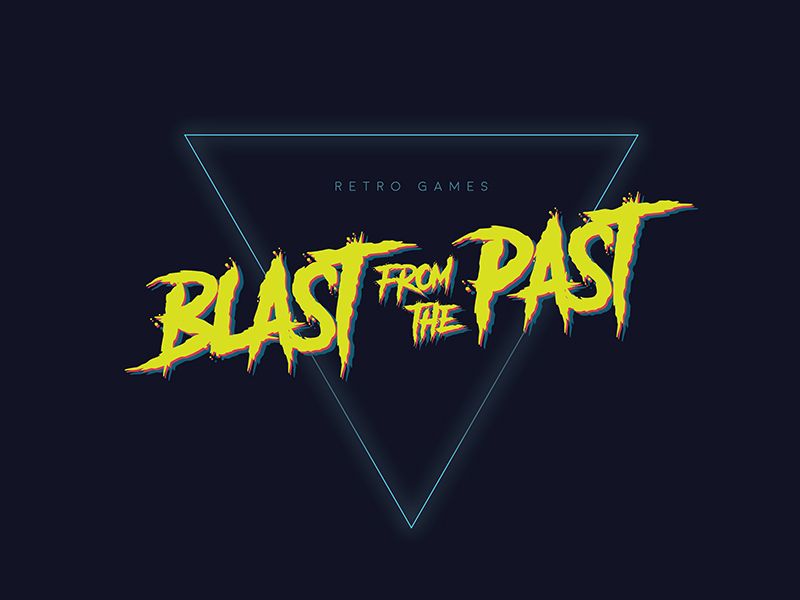Blast From the Past is a new segment that we will be featuring here at Completexbox. As always, the new year sparks new ideas, some we implement, and some we can. We are trialing this new feature out, and of course would appreciate your feedback, good or bad. One thing we do hope, is that you enjoy the nostalgia, and the trip down memory lane.
Now and again, we will be featuring a game from the past that is available for you to play via backward compatibility on your Xbox Series X|S and Xbox One Consoles. We will be sharing our views of the game, our memories, screenshots, and a link from the Xbox marketplace.
Today’s Blast from The Past is Daytona USA.

It’s time to get revved up with Daytona USA! Based on the classic arcade title, Daytona USA features enhanced graphics, tracks for all skill levels, and the original, hit soundtrack! Save your quarters – Xbox has brought the arcade straight to your living room with steering wheel and multiplayer support. Challenge your friends with up to eight player online races or the whole world via Xbox LIVE leaderboards!
Recently I was in the mood for a bit of racing action but from yesteryear, and Daytona USA certainly scratched that retro racing itch.
Daytona USA is an absolutely astonishing arcade racing game, a classic that is so much fun. I have fond memories of the arcades, and racing action games like these, from the minute I loaded up Sega’s Daytona USA I was transported back to the good old days of gaming, where gameplay was key, and a good experience was always guaranteed. The soundtrack wasn’t bad too!
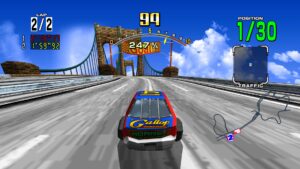
Past and Upbringing
Daytona USA is an arcade racing video game developed by Sega in 1993 and released by Sega in 1994. Players raced stock cars on one of three courses. The first game released on the Sega Model 2 three-dimensional arcade system board, a prototype debuted at Tokyo’s Amusement Machine Show in August 1993, and was location tested in Japan the same month, before the complete game released in March 1994. Daytona USA is one of the highest-grossing arcade games of all time.
Inspired by the popularity of the NASCAR motor racing series in the U.S., Daytona USA was developed by AM2 after a meeting of the heads of Sega’s regional offices for a game to debut the Model 2 hardware. The concept was suggested by Tom Petit, president of Sega’s American arcade division, with input from AM2 director Toshihiro Nagoshi, who became the game’s director and producer. Sega aimed to outperform Namco’s Ridge Racer (1993). The developers researched motorsports extensively; they used Satellite imagery and photography to map the Daytona International Speedway, and their experience developing Virtua Racing (1992) helped with lighting and camera control. Visual effects include texture filtering and texture mapping, a 60-frames-per second frame rate, and four different camera perspectives.
Daytona USA was a critical and commercial success, praised for its graphics, soundtrack and realism. It was ported to the Sega Saturn home console in 1995 and followed by sequels and enhancements for consoles and arcades. It was influential on the racing genre and has been frequently named one of the best video games of all time.
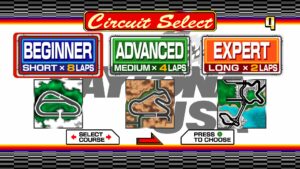
GamePlay
In Daytona USA, the player drives a stock car known as the Hornet. The player’s objectives are to outrun the competing cars and complete the race before time runs out, passing checkpoints to collect more time. Players begin in last place and compete against a field of up to 39 computer-controlled cars, dependent on the course selected. Three courses are available for play: Beginner, Advanced, and Expert, also known respectively as Three Seven Speedway, Dinosaur Canyon, and Seaside Street Galaxy. Adaptive difficulty is used; the first lap of each race measures the skill of the player and adjust the difficulty of opponents accordingly. For less skilled players, opposing cars open lanes for the player, while higher skilled players must deal with opponents that block their path. Additionally, the game’s physics include realistic driving mechanics, including drifting and power sliding. The steering wheel in the arcade cabinet utilises force feedback so players feel collisions and bumps.
Daytona USA‘s arcade version on the Model 2 can display up to 300,000 polygons per second, nearly double that of the previous Model 1. Visually, the game runs at 60 frames per second and utilises texture filtering, giving the visuals a smooth appearance. The game’s camera system presents four different view perspectives from which the game can be played, similar to Virtua Racing, and also includes the ability to view behind the car. The arcade version offers multiplayer and up to eight players can compete depending on the number of cabinets linked together. Linked deluxe cabinets may also include a camera pointing towards the driver’s seat, linked to a closed-circuit television to show the player on a separate screen. In multiplayer, only the lead driver needs to reach a checkpoint before time runs out. To keep players involved in multiplayer battles, rubber-banding is in place, ensuring all players stay involved in the race.
The Sega Saturn port does not include multiplayer, but includes an additional “Saturn” mode, which turns off the game’s timer and adds more cars from which the player can select. Additional “Endurance” and “Grand Prix” modes are also included, both of which require pit stops. Sustaining damage in a race in these modes will adversely affect the car’s performance. The Xbox 360 port included online multiplayer.

The Development History
In September 1992, Sega announced that it had partnered with the engineering group GE Aerospace to create its new arcade system board, the Model 2. The heads of Sega’s regional offices began discussing ideas for games to demonstrate the Model 2’s capabilities. Sega’s previous board, the Model 1, had debuted in 1992 with Virtua Racing, which was popular in Japan and Europe. Tom Petit, president of Sega’s American arcade division Sega Enterprises USA, suggested that NASCAR would be an attractive brand to use for a Model 2 game in the US. Though Sega Europe’s Vic Leslie had reservations due to the greater popularity of Formula One in Europe, Sega executives approved the concept. In the US for a meeting on the Model 2, director and producer Toshihiro Nagoshi was given tickets to a NASCAR race and recalled how it was a new experience for him because it was not a known style of racing in Japan.
Petit and Sega Enterprises USA chief of finance Masahiro Nakagawa began negotiations with representatives of the Daytona 500 at Daytona International Speedway for a license. To lower costs, Sega decided not to negotiate with NASCAR for a license, and so the game does not contain real sponsors, drivers, or cars. Development was handed to Sega AM2, a development division headed by Yu Suzuki, who had led development on popular racing games including Hang-On, Out Run, and Virtua Racing. Suzuki served as producer on Daytona USA alongside Nagoshi.
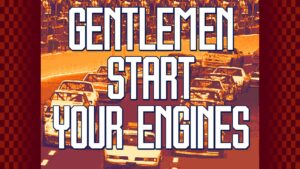
Sega mandated that Daytona USA had to be better than Namco’s 1993 racing game Ridge Racer. Whereas Ridge Racer focused on simulation, Daytona USA instead aimed for “funky entertainment”. AM2 split into two teams: one focused on Daytona USA while the other developed Virtua Fighter. Nagoshi read books and watched videos on NASCAR, although he found it difficult to convey the emotions of the sport to his staff in Japan. Game planner Makoto Osaki said he purchased a sports car and watched the NASCAR film Days of Thunder more than 100 times. Programmer Daichi Katagiri was an avid player of arcade racing games at the time and leaned on that experience.
The developers used satellite imagery and sent staff to photograph Daytona International Speedway; Nagoshi walked a full lap to get a feel for the banking in the corners. The team also considered Daytona International Speedway and Bristol Motor Speedway for the game’s beginner course. According to Nagoshi, because Daytona USA was not intended to be a simulation game, and because it would be sold in Japan and Europe in addition to North America, the oval and tri-oval designs were rejected as too repetitive. The final design for the beginner circuit, Three Seven Speedway, used the tri-oval layout with a sharper final turn that requires strong braking.
Katagiri said there was no need to develop software for rendering because the Model 2 hardware handled this. The team had difficulty with texture mapping; trial and error were used to find the most effective approach. For camera control and lighting effects, the team drew on its experience developing Virtua Racing. Daytona USA shares some features with Ridge Racer, including a drifting mechanic. Nagoshi initially planned not to include drifting as NASCAR stock cars do not drift but changed his mind when the team decided not to focus on simulation.
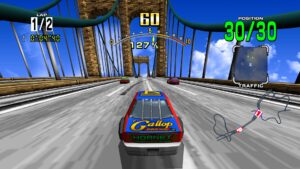
The soundtrack was composed by Takenobu Mitsuyoshi. Mitsuyoshi had no familiarity with stock car racing. He chose to include vocals after hearing Ridge Racer‘s techno soundtrack and deciding to try a different approach; he recorded his own vocals as the fastest way to get the music into the game. Each course has a corresponding song. “Let’s Go Away”, the Daytona theme, uses a mixture of rock and funk instrumentals, while “Sky High” leaned on Mitsuyoshi’s background in jazz fusion. A hidden track, “Pounding Pavement”, was inspired by “Hotel California” by the Eagles. For the arcade version, the songs were sampled onto a Yamaha sound chip, including the drums and Mitsuyoshi’s voice, then reconstructed by varying when the tracks would play and loop. Mitsuyoshi said this was the only way to include vocals, due to technical limitations of the Model 2. For the Saturn version, the vocals and instruments were rerecorded with real instruments.
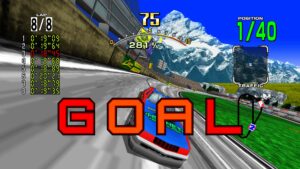
Updates and sequels
Daytona USA: Championship Circuit Edition, a reworked and expanded version of Daytona USA, was released in 1996 for the Saturn. Developed by Sega’s consumer software division, it used a modified version of the game engine used for Sega Rally Championship. Another enhanced port was released on Xbox Live Arcade. The Xbox 360 version was made backwards compatible with Xbox One on March 21, 2017.
Daytona USA 2: Battle on the Edge, an arcade-exclusive sequel using the Sega Model 3 hardware, was released in 1998. It is the only Daytona game that uses no courses or music from the original. Daytona USA 2001, a remake of Daytona USA and Championship Circuit Edition, was released in 2001 for the Dreamcast, with graphical upgrades, online multiplayer, and new courses. Daytona Championship USA, also referred to as Daytona USA 3, debuted in late 2016 as an arcade exclusive; it was the first Daytona arcade game in 18 years.
You can download the Xbox Version, playable on Xbox Series X|S and Xbox One via backward compatibility here DAYTONA USA (xbox.com)

